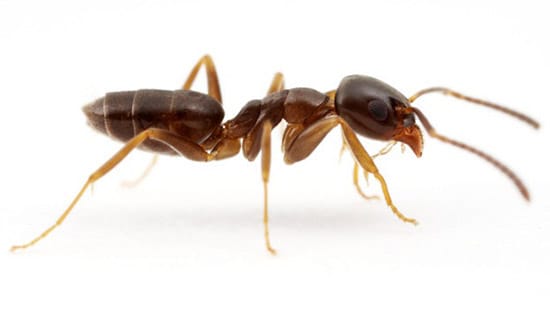Common Types of Ants

Ants can cause serious problems for your business. They can alarm or hurt people, risk food safety and tarnish your brand. Due to their size, it can be difficult to know what ant species you are dealing with and what risk they pose.
Use this guide to identify different types of ants and learn how to maintain a pest-free facility.
Where Ants Infest: An Overview
Ants can nest in a variety of materials and can be hidden or in plain sight. Depending on the kind of ant, they can build a nest in or near:
- foam insulation
- moisture-softened wood
- moisture sources such as voids near hot water pipes and around sinks
- walls, insulation and under floors and slabs near heat sources during winter
- warm, humid areas near food and water sources
- small crevices, woodwork and masonry
Types of Ants

Acrobat Ant (Crematogaster spp.)
- Found throughout the U.S.; name derived from how it raises its abdomen over its head and thorax when disturbed
- Workers are the same size, ¹⁄16” – ¹⁄8” (2.5 – 4 mm) long, light brown to black in color, have a distinctive heart-shaped abdomen and a thorax with one pair of dorsal spines
- Infests foam insulation and structures, preferring moisture-softened wood
- Nests in moderate to large colonies, with swarmers reproductive individuals with wings) active from mid-June to late September
- Can sting, bite and emit a repulsive odor

Carpenter Ant (Camponotus spp.)
- Found throughout the U.S.; hollows out galleries in moist or water-damaged wood for nests, which can worsen or exacerbate structural damage
- Workers are often noticeably larger than other ant species, ranging in size from ¹⁄8” – ¹⁄2” (3.5 – 13 mm) long; are black with combinations of red and black, and have an evenly rounded profile on upper side and no stinger
- Colonies usually have one queen; can have satellite nests separate from main colony with no queen
- Swarmers appear from May to August in the East and from February to June in the West
- Do not sting, but can have painful bites and emit a strong acidic odor when disturbed

Odorous House Ant (Tapinoma sessile)
- Found throughout the U.S.; named for strong, rotten coconut-like odor it produces when crushed
- Workers are the same size and ¹⁄16” – ⅛” (2.4 – 3.3 mm) long, brown to black in color, have 12-segmented antennae with no club; no stinger
- Major structure-invading species; constructs nests near moisture sources such as voids near hot water pipes and around sinks
- Prefers sweets but eats greasy foods such as meats and cheeses
- Colonies have multiple queens; ants from different colonies are friendly and move along trails

Pavement Ant (Tetramorium spp.)
- Found throughout the U.S.; named because nests are commonly located underneath and adjacent to pavement
- Workers are the same size, ¹⁄16” – ⅛” (2.5 – 3 mm) long, light brown to black with paler legs and antennae and a head and thorax that are furrowed/grooved with parallel lines; they are unevenly
- rounded profile and a thorax containing a pair of small spines
- Nests inside walls, insulation and under floors and slabs near heat sources during winter
- Swarmers appear outside in June and July but can emerge anytime inside; workers bite and sting only when provoked

Pharaoh Ant (Monomorium pharaonis)
- Found throughout the U.S.; named for the mistaken belief that this ant was one of Egypt’s plagues during the time of the pharaohs
- Workers are the same size, ¹⁄16” (1.5 mm) long with a pale, yellowish to reddish body and darker abdomen, an unevenly rounded profile, stinger
- Nests inside warm, humid areas near food and water sources; common in commercial buildings; of concern in hospitals where they will enter patient wounds, IV bottles and tubes; can carry more than a dozen pathogenic bacteria
- Nests are difficult to find as they tend to be hidden in wall voids and behind baseboards

Thief Ant (Solenopsis molesta)
- Found throughout the U.S.
- Workers are the same size, ¹⁄16” (1.3 mm) long, pale yellowish to dark brown, and have an unevenly rounded profile and miniscule stinger
- Nests near other ant species and robs them of food; forages in trails and prefers high-protein foods and sweets
- Nests inside in small crevices, woodwork and masonry; commonly enters structures during hot weather
- May carry disease, as it is known to feed on dead animals
More Pest Resources
With more than 12,400 ant species in the world, controlling ants may seem complex. By understanding ant behavior, you can easily eliminate them.
A key to dealing with ants at your facility is knowing how to locate an ant nest and understanding what attracted the ants in the first place.
With their potential to bite, sting and contaminate food, ants are more than just a nuisance. Ant elimination services help control a variety of ants.
Because of the potential for food contamination, cockroaches can have significant repercussions for restaurants and foodservice facilities.



